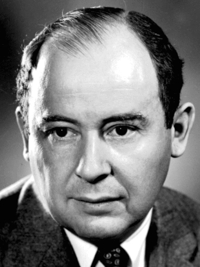Lifetime
Born: 28.12.1903, Budapest, Austria-HungaryPassed away: 08.02.1957, Washington, D.C., United States
About
John von Neumann (December 28, 1903 – February 8, 1957) was a Hungarian-American mathematician and polymath who made major contributions to many fields, including set theory, functional analysis, quantum mechanics, ergodic theory, continuous geometry, economics and game theory, computer science, numerical analysis, hydrodynamics, and statistics, as well as many other mathematical fields.He is generally regarded as one of the greatest mathematicians in modern history. The mathematician Jean Dieudonné called von Neumann "the last of the great mathematicians", while Peter Lax described him as possessing the most "fearsome technical prowess" and "scintillating intellect" of the century. Even in Budapest, in the time that produced geniuses like Theodore von Kármán (b. 1881), Leó Szilárd (b. 1898), Eugene Wigner (b. 1902), and Edward Teller (b. 1908), his brilliance stood out.
Von Neumann was a pioneer of the application of operator theory to quantum mechanics, in the development of functional analysis, a principal member of the Manhattan Project and the Institute for Advanced Study in Princeton (as one of the few originally appointed), and a key figure in the development of game theory[1][6] and the concepts of cellular automata,[1] the universal constructor, and the digital computer. In a short list of facts about his life he submitted to the National Academy of Sciences, he stated "The part of my work I consider most essential is that on quantum mechanics, which developed in Göttingen in 1926, and subsequently in Berlin in 1927–1929. Also, my work on various forms of operator theory, Berlin 1930 and Princeton 1935–1939; on the ergodic theorem, Princeton, 1931–1932." Along with Teller and Stanisław Ulam, von Neumann worked out key steps in the nuclear physics involved in thermonuclear reactions and the hydrogen bomb...
-Wikipedia
